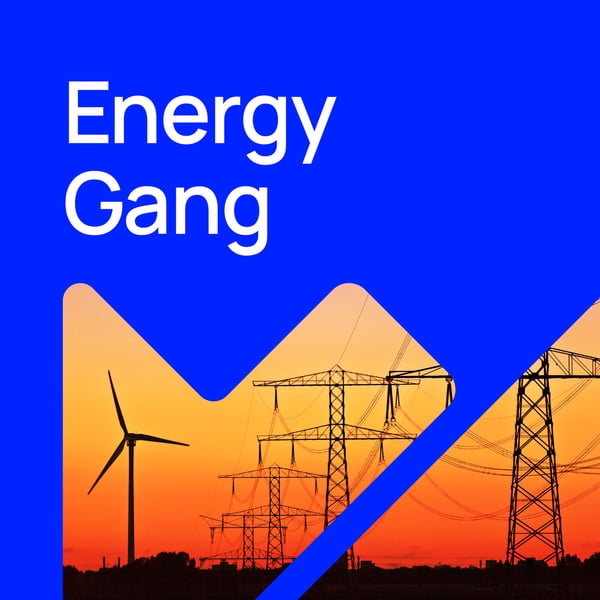Watt It Takes: How a NASA Roboticist Built a Groundbreaking Solar Tracker
The Energy Gang
Wood Mackenzie
4.6 • 1.3K Ratings
🗓️ 19 June 2018
⏱️ 47 minutes
🧾️ Download transcript
Summary
Leila Madrone was constantly looking for creative ways to use robots. In the mid 2000's, she co-founded a music group called Ensemble Robot, which featured robots that played music.
"I had this great passion to use robotics to have meaning in the world," said Madrone. Later, Madrone worked for NASA's intelligent robotics group.
Then she caught the solar bug: "Solar seemed like where the most possibility was for the future."
She teamed up with Saul Griffith, an expert in self-replicating machines, to start Sunfolding. It started with a seemingly simple idea: Solar trackers move solar panels over the day to create the most energy. But they’re made of heavy, expensive components. What if you could develop a cheaper, more efficient tracker using premium plastic materials and the power of air to maximize energy production?
With that idea, Leila built Sunfolding’s AirDrive technology that combines the functionality of motors, gears, dampers and batteries into a single component primarily composed of air.
In this edition of Watt It Takes, Powerhouse CEO Emily Kirsch interviews Leila Madrone about her path from music-making NASA roboticist to solar-tracker CEO.
This podcast is brought to you by Sense. Sense installs in your home's electrical panel and provides insight into your energy use and home activity through iOS, Android and web apps. Find out more.
Watt It Takes is a live interview series produced by Powerhouse in partnership with GTM. The conversation was recorded live in Oakland, California.
Listen to our other episodes of Watt It Takes:
- Nancy Pfund’s Pro Tips for Getting Started in Cleantech
- SunPower Founder Dick Swanson’s Guide to Launching a Cleantech Startup
- Lessons From the Fall of Sungevity
- Dan Shugar, the King Midas of Solar
- A History of Greentech Media With Scott Clavenna
- Sungage's Sara Ross on Starting a Solar Loan Company
- Jigar Shah on the Origin Story of SunEdison
- The Origin Story of Mosaic With Billy Parish
Like our shows? Make sure to give The Interchange, The Energy Gang and Political Climate a rating and review on Apple podcasts. And make sure to subscribe to our shows on Apple podcasts, Google Play, Stitcher, or anywhere you get your podcasts.
See Privacy Policy at https://art19.com/privacy and California Privacy Notice at https://art19.com/privacy#do-not-sell-my-info.
Transcript
Click on a timestamp to play from that location
| 0:00.0 | This week on what it takes, how a NASA roboticist created a tracking company that uses air to replace traditional components. |
| 0:08.0 | We'll hear from Leila Madron, the chief technical officer of Sunfolding, about why she passed up a job at Tesla to |
| 0:14.4 | envision the future of solar electromechanics. First though a word about our |
| 0:18.5 | sponsor, Sense. Bring your home into the future with Sense. It's a little orange box that connects to your electric panel |
| 0:24.8 | and samples power over a million times per second. |
| 0:27.8 | It's incredibly simple, it's this little sleek box, |
| 0:30.2 | but boy does it have some complex processing power. |
| 0:33.0 | Sense lets you know what devices are on in your home |
| 0:35.7 | and how much energy they're using in real time |
| 0:38.1 | so you can save energy and see what's happening all from your smartphone. |
| 0:41.8 | To find out more visit sense |
| 0:43.3 | dot com slash energy gang that's sense se s e s e sence dot com slash energy gang Hey, welcome to another edition of What It Takes, an interview series produced by Powerhouse |
| 0:57.4 | and Green Tech Media. I'm Stephen Lacy, and this week Powerhouse CEO Emily Kirsch talks with Lila Madron, the CEO of Sun Folding. |
| 1:06.1 | They're going to talk about how Lila cultivated the mental freedom to give up a stable job and pursue |
| 1:11.2 | her passion for reinventing solar technologies. |
| 1:14.1 | The conversation was recorded live in Oakland, California at Powerhouse's headquarters, and |
| 1:18.7 | Emily Fritzie Powerhouse's director of strategy sets the stage and then Emily Kirsch takes over. |
| 1:25.0 | I first heard about Leela Madron back in 2015 when I was working at the Department of Energy's Advanced |
| 1:31.1 | Research Projects Agency Energy, a program that funds early |
| 1:35.2 | stage whiz-Baying energy technology and de-risk it so that the private sector is more likely |
| 1:41.0 | to continue funding it. |
| 1:43.0 | Lela at the time was developing the prototype |
... |
Please login to see the full transcript.
Disclaimer: The podcast and artwork embedded on this page are from Wood Mackenzie, and are the property of its owner and not affiliated with or endorsed by Tapesearch.
Generated transcripts are the property of Wood Mackenzie and are distributed freely under the Fair Use doctrine. Transcripts generated by Tapesearch are not guaranteed to be accurate.
Copyright © Tapesearch 2025.

